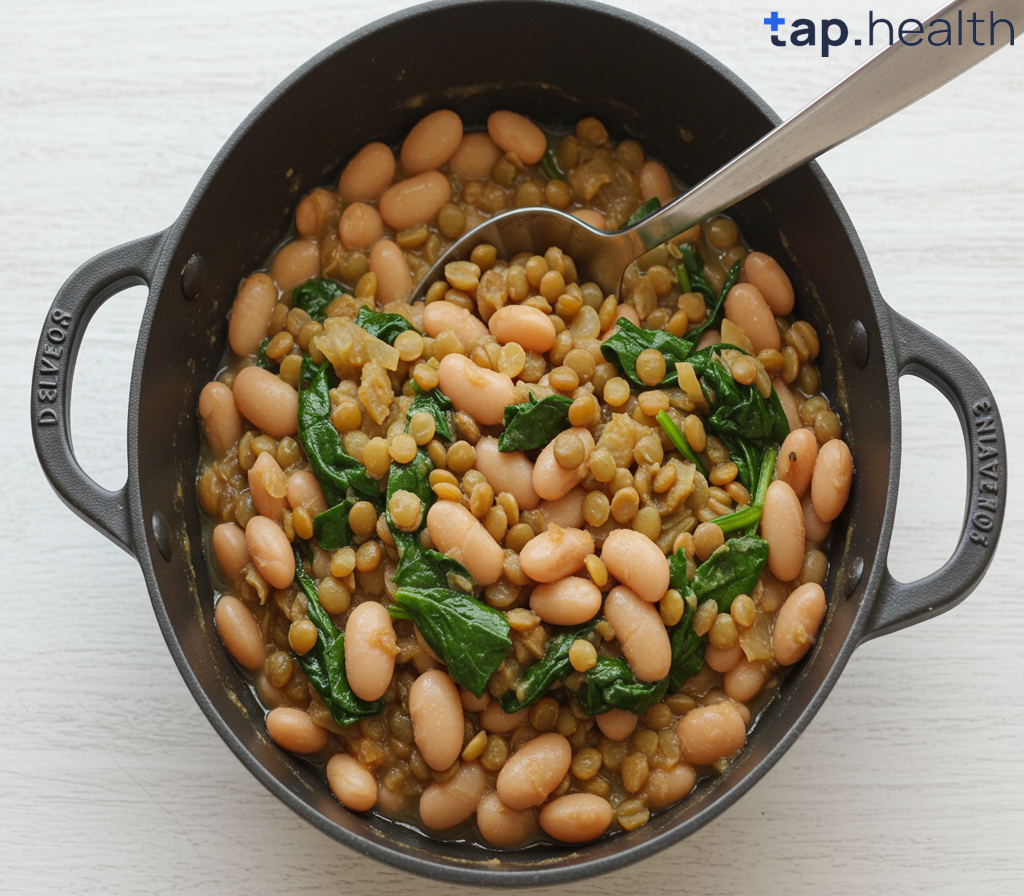Navy beans are small, white legumes that are widely used in soups, stews, and casseroles. They are a rich Diabetes is a chronic condition that affects how your body processes sugar. Managing blood sugar levels is key to living a healthy life with diabetes, and diet plays a crucial role in this process. One food that is frequently discussed for its potential benefits for diabetic patients is navy beans. But, how good are navy beans for people with diabetes? Can they help control blood sugar and offer other health benefits?
In this blog post, we’ll explore whether navy beans are good for diabetic patients, how they affect blood sugar levels, and how they can be included in a healthy diabetic diet. We’ll also dive deep into the nutritional profile of navy beans, their health benefits, and answer some common questions about including them in a diabetes-friendly meal plan.
What Are Navy Beans?
Before we dive into the health benefits, let’s first understand what navy beans are. Navy beans, also known as Phaseolus vulgaris, are small, oval-shaped beans with a smooth white appearance. They are also referred to as haricot beans or white beans. Navy beans are a popular ingredient in many cuisines around the world and are often used in soups, salads, and casseroles due to their mild flavor and creamy texture.
Nutritional Profile of Navy Beans
Navy beans are packed with nutrients that are essential for good health, especially for individuals with diabetes. Below is the nutritional breakdown of one-half cup of cooked navy beans:
- Calories: 127 kcal
- Protein: 8.3 grams
- Carbohydrates: 22.5 grams
- Dietary Fiber: 6.3 grams
- Fat: 0.5 grams
- Vitamins & Minerals: Navy beans are rich in folate, iron, magnesium, and potassium.
Why Are Navy Beans a Good Choice for Diabetic Patients?
Now that we know what navy beans are and their basic nutritional profile, let’s explore why they can be beneficial for diabetic patients.
Is Navy Bean Good for Diabetic Patients?
Yes, navy beans are a great food choice for people with diabetes. There are several reasons why navy beans are beneficial, and the primary reasons revolve around their high fiber content, low glycemic index, and rich protein profile. Let’s break down how these factors contribute to making navy beans diabetes-friendly.
1. High Fiber Content
Navy beans are an excellent source of dietary fiber, particularly soluble fiber. Soluble fiber is important because it helps to slow down the absorption of sugar into the bloodstream, which can help prevent blood sugar spikes after meals.
Benefits of Fiber for Diabetic Patients:
- Improved Blood Sugar Control: Fiber helps slow the digestion of carbohydrates, leading to more gradual increases in blood sugar. This can help stabilize blood sugar levels throughout the day.
- Satiety and Weight Management: Fiber-rich foods like navy beans keep you feeling full longer, which can help with weight management. Maintaining a healthy weight is important for managing type 2 diabetes.
- Digestive Health: Fiber promotes regular bowel movements and improves gut health, both of which are important for overall well-being.
2. Low Glycemic Index (GI)
The glycemic index (GI) measures how quickly a food raises blood sugar levels. Foods with a low GI release sugar into the bloodstream slowly, which helps avoid rapid spikes in blood glucose.
Navy beans have a low GI of 29, making them an excellent choice for people with diabetes. This means that navy beans are digested and absorbed more slowly compared to high-GI foods, helping to maintain stable blood sugar levels.
Glycemic Index and Diabetes:
- Preventing Blood Sugar Spikes: Eating foods with a low GI, such as navy beans, helps keep blood sugar levels from rising too quickly.
- Improved Long-Term Blood Sugar Control: Consuming low-GI foods regularly can improve long-term blood sugar control, which is important for managing diabetes.
3. Rich in Protein
Navy beans are also a good source of plant-based protein, containing around 8 grams of protein per half-cup serving. Protein plays a key role in managing blood sugar levels by stabilizing glucose. Including protein in your meals helps slow down the absorption of carbohydrates, preventing spikes in blood sugar.
Protein and Diabetes:
- Blood Sugar Regulation: Protein helps to regulate blood sugar levels by reducing the impact of carbohydrates on blood sugar.
- Muscle Health: Protein supports muscle growth and repair, which is particularly important for diabetic patients as muscle mass is linked to improved insulin sensitivity.
4. Heart Health Benefits
People with diabetes are at a higher risk of developing heart disease. Consuming navy beans can be beneficial for heart health due to their high fiber and antioxidant content. These nutrients help lower cholesterol, reduce blood pressure, and protect the heart.
Navy beans are rich in potassium and magnesium, two minerals that are crucial for maintaining healthy blood pressure. Since hypertension is a common concern for people with diabetes, adding navy beans to the diet can help manage blood pressure levels.
5. Rich in Antioxidants
Navy beans contain various antioxidants that help protect the body from free radicals, which can damage cells and contribute to chronic diseases. Antioxidants in navy beans, such as polyphenols, help reduce inflammation, a common problem in people with diabetes.
Antioxidants and Diabetes:
- Reduced Inflammation: Chronic inflammation is often linked to insulin resistance. The antioxidants in navy beans help reduce inflammation and improve insulin sensitivity.
- Improved Insulin Sensitivity: Reducing oxidative stress can improve the body’s ability to respond to insulin, which is essential for managing blood sugar levels.
How to Include Navy Beans in a Diabetic Diet
Navy beans can be easily incorporated into a diabetic meal plan. Here are some simple and delicious ways to include navy beans in your diet:
1. Navy Bean Soup
A warm and hearty bowl of navy bean soup is a perfect diabetic-friendly meal. You can make a simple soup with navy beans, vegetables, and low-sodium broth for a filling and nutritious meal.
2. Navy Bean Salad
Navy beans can be added to salads for an extra boost of protein and fiber. Combine cooked navy beans with fresh vegetables, olive oil, and a light dressing for a healthy and satisfying meal.
3. Navy Bean Chili
Chili made with navy beans is a comforting and filling dish. You can make a low-sugar, low-sodium chili with navy beans, lean ground turkey, tomatoes, and spices for a diabetes-friendly version of this classic meal.
4. Navy Bean Dip
Make a healthy dip by blending cooked navy beans with garlic, lemon juice, and olive oil. This makes for a nutritious snack when paired with fresh veggies or whole-grain crackers.
Are There Any Side Effects of Eating Navy Beans?
Navy beans are generally safe for most people, but there are a few potential side effects that you should be aware of:
1. Gas and Bloating
Beans, including navy beans, are known to cause gas and bloating in some people. This is due to the high fiber content and certain sugars (oligosaccharides) that can be hard to digest. To reduce the risk of bloating, try soaking the beans overnight before cooking them and discarding the soaking water.
2. Allergic Reactions
Though rare, some individuals may be allergic to beans. If you experience symptoms like swelling, itching, or difficulty breathing after eating navy beans, it’s best to avoid them and consult a healthcare professional.
Real-Life Scenario
Ravi, a 45-year-old man with type 2 diabetes, struggled with sugar spikes after meals. His dietitian suggested adding half a cup of boiled navy beans to his lunch instead of white rice. Within a few weeks, his blood sugar readings improved, and he felt full for longer periods, reducing his cravings for unhealthy snacks.
Expert Contribution
Endocrinologists and dietitians often recommend legumes, including navy beans, for diabetic patients. According to research published in the American Journal of Clinical Nutrition, regular consumption of beans helps improve glycemic control and reduces the risk of cardiovascular complications in people with diabetes.
Recommendations Grounded in Proven Research and Facts
- Portion control is key: Half a cup of navy beans contains around 100 calories and 8 grams of fiber, making it a diabetes-friendly serving.
- Pair with vegetables: Combining beans with non-starchy vegetables helps balance blood sugar even better.
- Avoid added fats: Cooking beans with excess oil, butter, or cream can reduce their health benefits.
- Include in a balanced diet: Replacing refined carbs like white rice or bread with navy beans can support better blood sugar management.
- Consistency matters: Eating beans regularly—at least 2–3 times a week—has been linked to improved blood sugar control.
FAQs on Is navy bean good for diabetic patients?
1. Can Navy Beans Help Control Blood Sugar?
Yes, navy beans are great for controlling blood sugar due to their high fiber content, low glycemic index, and rich protein profile. They help slow down the absorption of sugar into the bloodstream, preventing blood sugar spikes.
2. Are Navy Beans Better than Other Beans for Diabetes?
Navy beans are a great choice for diabetes, but other beans like black beans, kidney beans, and chickpeas are also beneficial. The key is to include a variety of beans in your diet to get different nutrients and benefits.
3. How Should I Prepare Navy Beans for a Diabetic Diet?
Navy beans can be included in a diabetic diet by preparing them in various ways, such as soups, salads, dips, or chili. Be sure to cook them without adding too much sugar or salt, which could raise blood sugar levels.
4. Can I Eat Navy Beans Every Day?
Yes, you can eat navy beans every day as part of a balanced diet. They are a great source of protein, fiber, and essential nutrients. Just be mindful of portion sizes, as beans are calorie-dense.
5. Can Navy Beans Cause Weight Gain?
Navy beans are a filling, fiber-rich food that can actually aid in weight management by helping you feel fuller for longer. However, they should be consumed in moderation as part of a balanced diet.
Conclusion
Navy beans are an excellent food choice for diabetic patients due to their high fiber content, low glycemic index, and rich protein profile. They help regulate blood sugar levels, improve heart health, and offer various other health benefits. By incorporating navy beans into your diet, you can support better blood sugar control and overall health. Whether you enjoy them in soups, salads, or chili, navy beans are a versatile and nutritious addition to any diabetes-friendly meal plan.



